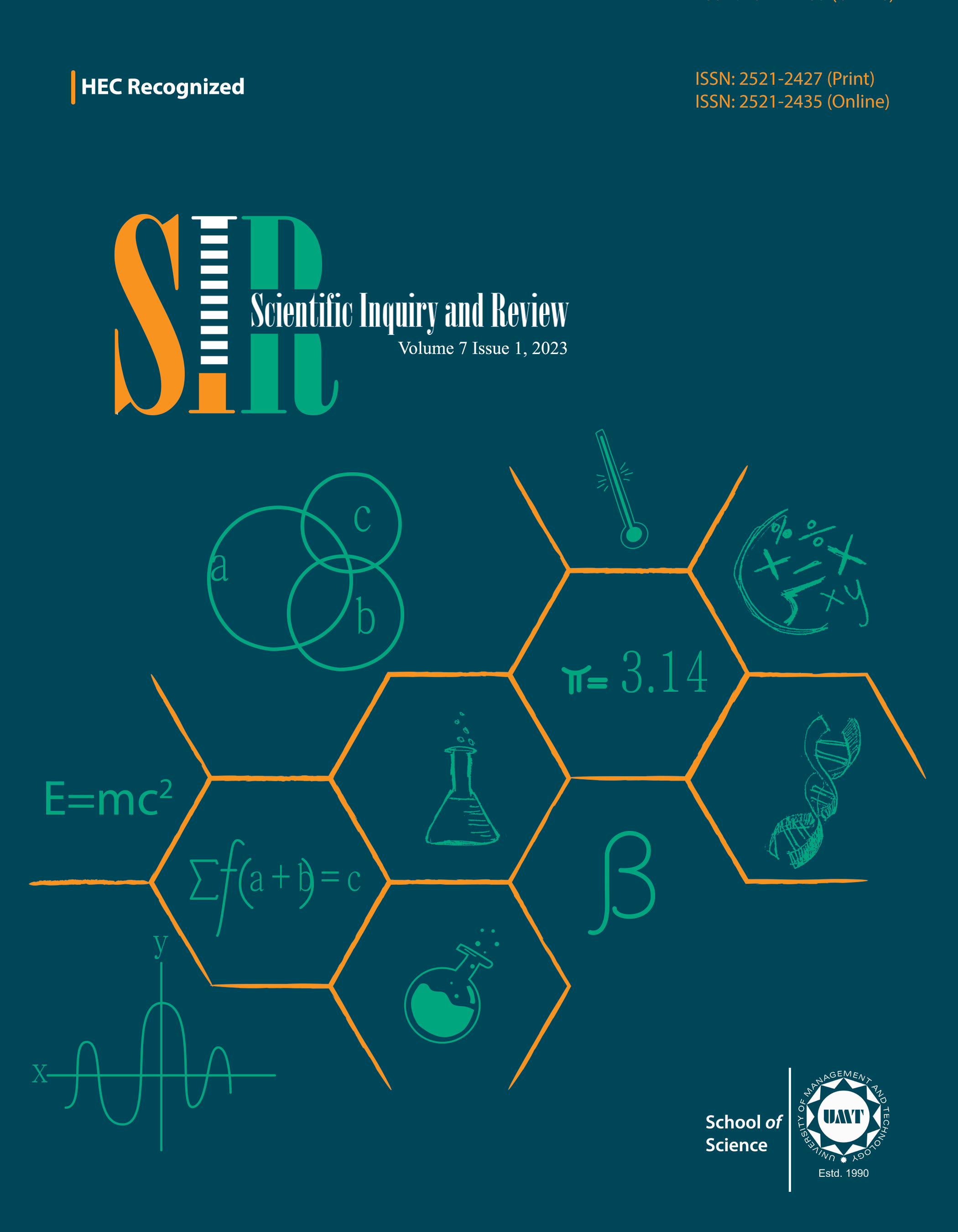Measuring the Awareness of Polycystic Ovarian Syndrome (PCOS) among Women in Punjab, Pakistan
Abstract
 Abstract Views: 98
Abstract Views: 98
Polycystic ovarian syndrome (PCOS) is the most prevailing endocrine disorder among women of reproductive age, worldwide. Its prevalence is 52% in Pakistani women and the rate of infertility is gradually increasing. It can be treated through early diagnosis, management of symptoms, and a healthy lifestyle. This cross-sectional study aimed to determine the level of awareness and knowledge regarding PCOS in the women of Punjab, Pakistan. For this purpose, a total of 350 women between the ages of 16 and 50 years were included in the current study. data was obtained through a questionnaire and analyzed through SPSS (version 25). The results determined that 56% of women were found to have the knowledge of PCOS, while 44% had never heard about it. Furthermore, about 67% of 196 PCOS-aware women were unaware of its signs and symptoms. Moreover, in 14% of the cases, a friend was the source of knowledge regarding PCOS. Whereas, approximately 10% of these women had heard about the syndrome through education, 9% through their family, 7% through various media such as newspapers, television, and social media, and 17% through other sources including general physicians and gynecologists. It was concluded that only 33% of the participants who claimed to have heard of PCOS were aware of its symptoms, whereas 67% were unaware of them. A total of 152 women, out of 350, had never heard about PCOS.
Downloads
References
Li D, Jiao J, Zhou YM, Wang XX. Epigenetic regulation of traf2-and Nck-interacting kinase (TNIK) in polycystic ovary syndrome. Am J Transl Res. 2015;7(6):1152–1160.
Li J, Wu Q, Wu XK, et al. Effect of exposure to second-hand smoke from husbands on biochemical hyperandrogenism, metabolic syndrome and conception rates in women with polycystic ovary syndrome undergoing ovulation induction. Hum Reprod. 2018;33(4):617–25. https://doi.org/10.1093/humrep/dey027
Azziz R, Carmina E, Chen Z, et al. Polycystic ovary syndrome. Nat Rev Dis Primers. 2016;2:e16057. https://doi.org/10.1038/nrdp.2016.57
Khan IA, Movva S, Shaik NA, et al. Investigation of Calpain 10 gene polymorphism in Asian Indians with gestational diabetes mellitus. Meta Gene. 2014;2:299–306. https://doi.org/10.1016/j.mgene.2014.03.001
Panda PK, Rane R, Ravichandran R, Singh S, Panchal H. Genetics of PCOS: A systematic bioinformatics approach to unveil the proteins responsible for PCOS. Genom Data. 2016;8:52–60. https://doi.org/10.1016/j.gdata.2016.03.008
Ingudomnukul E, Baron-Cohen S, Wheelwright S, Knickmeyer R. Elevated rates of testosterone- related disorders in women with autism spectrum conditions. Horm Behav. 2007;51(5):597–604. https://doi.org/10.1016/j.yhbeh.2007.02.001
Teede H, Deeks A, Moran L. Polycystic ovary syndrome: A complex condition with psychological, reproductive and metabolic manifestations that impacts on health across the lifespan. BMC Med. 2010;8:e41. https://doi.org/10.1186/1741-7015-8-41
Fauser B, Tarlatzis B, Rebar R, et al. Consensus on women's health aspects of polycystic ovary syndrome (PCOS). Hum Reprod. 2011;27(1):14–24. https://doi.org/10.1093/humrep/der396
Lowenstein EJ. Diagnosis and management of the dermatologic manifestations of the polycystic ovary syndrome. Dermatol Ther. 2006;19(4):210–23. https://doi.org/10.1111/j.1529-8019.2006.00077.x
Deeks AA, Gibson-Helm M, Paul E, Teede HJ. Is having polycystic ovary syndrome a predictor of poor psychological function including anxiety and depression? Hum Reprod. 2011;26(6):1399–1407. https://doi.org/10.1093/humrep/der071
Lujan ME, Jarrett BY, Brooks ED, et al. Updated ultrasound criteria for polycystic ovary syndrome: reliable thresholds for elevated follicle population and ovarian volume. Hum Reprod. 2013;28(5):1361–1368. https://doi.org/10.1093/humrep/det062
Kim JJ, Hwang KR, Choi YM, et al. Complete phenotypic and metabolic profiles of a large consecutive cohort of untreated Korean women with polycystic ovary syndrome. Fertil Steril. 2014;101(5):1424–1430. https://doi.org/10.1016/j.fertnstert.2014.01.049
Diamanti- Kandarakis E, Dunaif A. Insulin resistance and the polycystic ovary syndrome revisited: An update on mechanisms and implications. Endocr Rev. 2012;33(6):981–1030. https://doi.org/10.1210/er.2011-1034
Oróstica L, Rosas C, Plaza-Parrochia F, et al. Altered steroid metabolism and insulin signaling in PCOS endometria: Impact in tissue function. Curr Pharm Des. 2016;22(36):5614–5624.
Webber L, Stubbs S, Stark J, et al. Formation and early development of follicles in the polycystic ovary. Lancet. 2003;362(9389):1017–1021. https://doi.org/10.1016/S0140-6736(03)14410-8
Maciel GAR, Baracat EC, Benda JA, et al. Stockpiling of transitional and classic primary follicles in ovaries of women with polycystic ovary syndrome. J Clin Endocrinol Metab. 2004;89(11):5321–5327. https://doi.org/10.1210/jc.2004-0643
Ibanez L, Oberfield SE, Witchel S, et al. An international consortium update: Pathophysiology, diagnosis, and treatment of polycystic ovarian syndrome in adolescence. Horm Res Paediatr. 2017;88:371–395. https://doi.org/10.1159/000479371
Armengaud JB, Charkaluk ML, Trivin C, et al. Precocious pubarche: Distinguishing late-onset congenital adrenal hyperplasia from premature adrenarche. J Clin Endocrinol Metab. 2009;94(8):2835–2840. https://doi.org/10.1210/jc.2009-0314
Mohamed W, Hassan H. Effect of instructional supportive guideline for improving women's awareness towards endometriosis. Am J Nurs Res. 2020;8(1):38–47. https://doi.org/10.12691/ajnr-8-1-5
Belenkaia LV, Lazareva LM, Walker W, Lizneva DV, Suturina LV. Criteria, phenotypes and prevalence of polycystic ovary syndrome. Minerva Ginecol. 2019;71(3):211–223. https://doi.org/10.23736/s0026-4784.19.044046
Sunanda B, Nayak S. A study to assess the knowledge regarding PCOS (polycystic ovarian syndrome) among nursing students at NUINS. J Health Allied Sci NU. 2016;6(3):24–26. https://doi.org/10.1055/s-0040-1708657
Sills ES, Perloe M, Tucker MJ, Kaplan CR, Genton MG, Schattman GL. Diagnostic and
treatment characteristics of polycystic ovary syndrome: Descriptive measurements of patient perception and awareness from 657 confidential self-reports. BMC Women's Health. 2001;1:e3. https://doi.org/10.1186/1472-6874-1-3
Sanchez N. A life course perspective on polycystic ovary syndrome. Int J Women's Health. 2014;6:115–122.
Joshi B, Mukherjee S, Patil A, Purandare A, Chauhan S, Vaidya R. A cross-sectional study of polycystic ovarian syndrome among adolescent and young girls in Mumbai, India. Indian J Endocrinol Metab. 2014;18(3):317–324. https://doi.org/10.4103%2F2230-8210.131162
Maiya AG, Sheela R, Kumar P. Exercise-induced weight reduction and fertility outcomes in women with polycystic ovarian syndrome who are obese and infertile: A preliminary report'. J Exerc Sci Physiother. 2008;4(1):30–34.
Nidhi R, Padmalatha V, Raghuram Nagarathna RA. Effect of holistic yoga program on anxiety symptoms in adolescent girls with polycystic ovarian syndrome: A randomized control trial. Int J Yoga. 2012;5(2):112–117. https://doi.org/10.4103%2F0973-6131.98223
Azziz R, Carmina E, Dewailly D, et al. The Androgen Excess and PCOS Society criteria for the polycystic ovary syndrome: the complete task force report. Fertil Steril. 2009;91(2):456-488. https://doi.org/10.1016/j.fertnstert.2008.06.035
Vause TD, Cheung AP, Sierra S, et al. Ovulation induction in polycystic ovary syndrome. J Obstet Gynaecol Can. 2010;32(5):495–502. https://doi.org/10.1016/S1701-2163(16)34504-2
Copyright (c) 2023 Alina Rafique

This work is licensed under a Creative Commons Attribution 4.0 International License.






